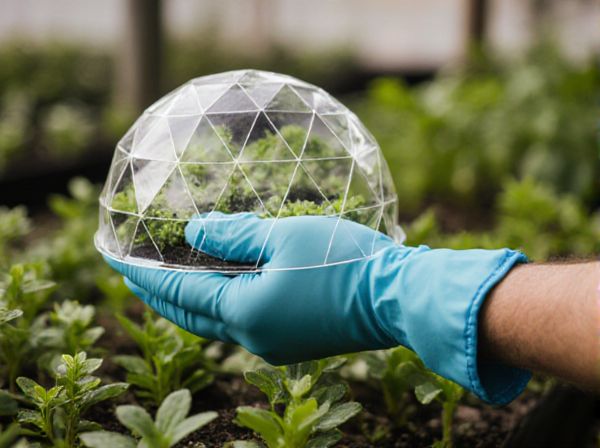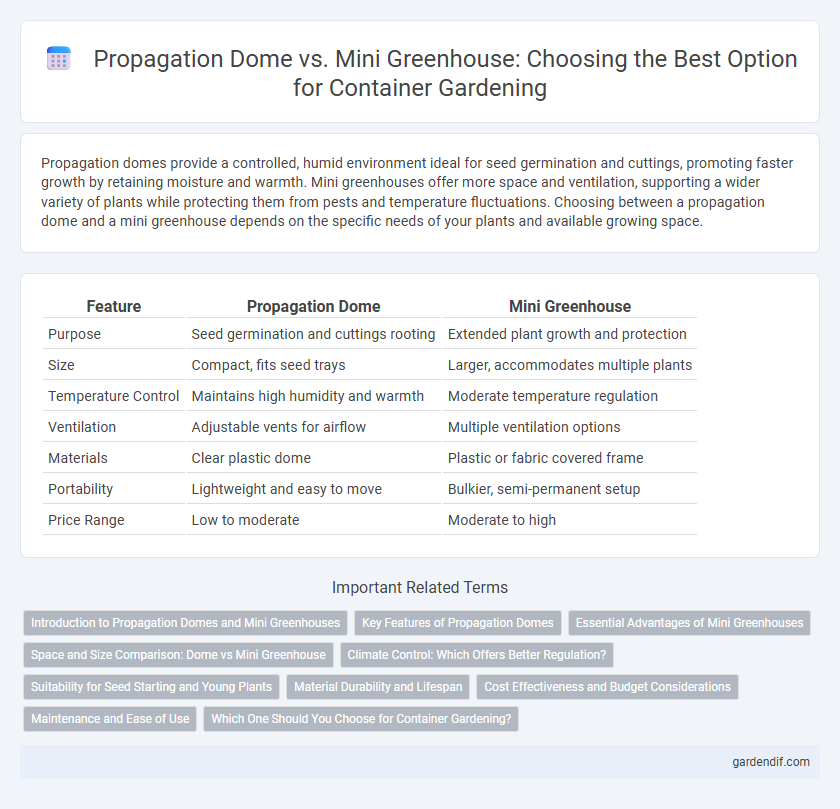
Propagation Dome vs Mini Greenhouse Illustration
Propagation domes provide a controlled, humid environment ideal for seed germination and cuttings, promoting faster growth by retaining moisture and warmth. Mini greenhouses offer more space and ventilation, supporting a wider variety of plants while protecting them from pests and temperature fluctuations. Choosing between a propagation dome and a mini greenhouse depends on the specific needs of your plants and available growing space.
Table of Comparison
| Feature | Propagation Dome | Mini Greenhouse |
|---|---|---|
| Purpose | Seed germination and cuttings rooting | Extended plant growth and protection |
| Size | Compact, fits seed trays | Larger, accommodates multiple plants |
| Temperature Control | Maintains high humidity and warmth | Moderate temperature regulation |
| Ventilation | Adjustable vents for airflow | Multiple ventilation options |
| Materials | Clear plastic dome | Plastic or fabric covered frame |
| Portability | Lightweight and easy to move | Bulkier, semi-permanent setup |
| Price Range | Low to moderate | Moderate to high |
Introduction to Propagation Domes and Mini Greenhouses
Propagation domes create a controlled humidity environment ideal for seed germination and cuttings, offering consistent moisture retention and airflow. Mini greenhouses provide a larger, more versatile growing space suitable for nurturing seedlings and small plants under regulated temperature and light conditions. Both structures enhance early plant development but differ in size and functionality, with propagation domes optimized for moisture control and mini greenhouses for broader climate management.
Key Features of Propagation Domes
Propagation domes offer a controlled humidity environment with vent holes to regulate moisture and prevent mold, ideal for seed starting and cuttings. Their transparent design maximizes light exposure while maintaining consistent warmth, accelerating germination and root development. Unlike mini greenhouses, propagation domes are compact, stackable, and designed specifically for delicate propagation stages.
Essential Advantages of Mini Greenhouses
Mini greenhouses offer superior temperature regulation compared to propagation domes, creating an ideal microclimate for plant growth by trapping heat and maintaining consistent humidity levels. Their sturdy construction allows for better ventilation control, reducing the risk of mold and fungal diseases typically associated with propagation domes. Compact yet robust, mini greenhouses extend the growing season and provide enhanced protection against pests and harsh weather conditions, making them essential for container gardening.
Space and Size Comparison: Dome vs Mini Greenhouse
Propagation domes are typically smaller and designed to fit directly over seed trays or small containers, offering a compact footprint ideal for limited indoor spaces. In contrast, mini greenhouses provide more vertical space and larger dimensions, allowing for the cultivation of bigger plants or multiple seedlings simultaneously. The choice between the two depends on the available space and the scale of propagation needed, with domes favoring efficiency and mini greenhouses supporting greater plant growth volume.
Climate Control: Which Offers Better Regulation?
Propagation domes provide superior humidity control by trapping moisture effectively, creating an ideal microenvironment for seed germination and cuttings. Mini greenhouses offer broader temperature regulation through better ventilation options, supporting plant growth over longer periods. For precise climate control focused on moisture retention, propagation domes excel, while mini greenhouses deliver more versatile temperature management.
Suitability for Seed Starting and Young Plants
Propagation domes provide a controlled humidity environment ideal for seed germination and the early growth stages of young plants, enhancing moisture retention and reducing transplant shock. Mini greenhouses offer better temperature regulation and protection from pests, making them suitable for slightly older seedlings that require more space and airflow. Both containers support successful plant development, but propagation domes excel in creating optimal conditions for delicate seeds and fragile seedlings.
Material Durability and Lifespan
Propagation domes typically feature lightweight plastic or polycarbonate materials that provide moderate durability and a lifespan of 1 to 3 years under regular use. Mini greenhouses often use sturdier materials such as reinforced polyethylene, metal frames, and UV-resistant covers, extending their lifespan to 5 years or more. The increased material durability of mini greenhouses offers better protection against environmental elements, making them a more long-term investment for container gardening.
Cost Effectiveness and Budget Considerations
Propagation domes generally offer a more cost-effective solution for seed starting and small plant propagation compared to mini greenhouses, as they require less material and occupy minimal space. Mini greenhouses, although initially more expensive, provide greater durability and extended growing seasons, potentially reducing the need for frequent replacements. Budget-conscious gardeners often prefer propagation domes for short-term use and limited space, whereas mini greenhouses serve as a long-term investment for more extensive gardening projects.
Maintenance and Ease of Use
The Propagation Dome offers superior ease of use with its lightweight design and simple snap-on lid, requiring minimal maintenance due to its durable, mold-resistant plastic. Mini greenhouses often demand more upkeep, including regular watering, ventilation adjustments, and cleaning to prevent mildew buildup. For gardeners prioritizing low-maintenance solutions, the Propagation Dome provides efficient humidity control and hassle-free operation ideal for seed starting and cuttings.
Which One Should You Choose for Container Gardening?
Propagation domes maintain higher humidity levels ideal for seed germination and cuttings, while mini greenhouses offer more space and better temperature control for young plants. For container gardening, propagation domes are best suited for starting seeds and rooting cuttings efficiently, whereas mini greenhouses provide a versatile environment for nurturing established plants. Choose a propagation dome for faster germination or a mini greenhouse for extended growing space and climate management.
Propagation Dome vs Mini Greenhouse Infographic

 gardendif.com
gardendif.com